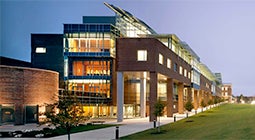Preparative Ultracentrifuges, High-Capacity "Superspeed" Centrifuges, and routine Centrifuges
High Capacity Centrifuges
The Microbiology Core Facility has two Thermo/Sorvall Evolution RC refrigerated centrifuges, which are typically used for harvesting microorganism cells and other laboratory separation processes.
There are large rotors (SLC-6000) that can centrifuge 4.8 to 6 liters of cell culture at up to about 7000 RCF, which is sufficient to pellet most bacterial cells.
There are several smaller rotors that can generate up to about 50,000 RCF, which is useful for many laboratory separations, but is still only 10% of the force that our ultracentrifuges are capable of providing.
Rotors
- SLC-6000
- F14S-6x250
- F13-14x50cy
- F18-12x50
- F21-8x50y
The values below are only approximate guides.Please refer to the rotor and tube specifications before operating any centrifuge.
| Rotor Designation | Volume of Each Tube * | Number of Tubes in Rotor |
|---|---|---|
| SLC-6000 | 600 mL | 6 |
| F14S-6x250 | 250 mL | 6 |
| F13-14x50cy | 50 mL | 14 |
| F18-12x50 | 50 mL | 12 |
| F21-8x50y | 50 mL | 8 |
* Volume may be lower for caps that cannot hold liquid at full speed
Routine Laboratory Centrifuges
High Capacity Centrifuge for routine laboratory work including centrifugation of 96-well type plates
The Eppendorf 5810R is a centrifuge is capable of 3,200 RCF. Typically, it can hold many more tubes than the “Superspeed” centrifuges:
| Type of tube | Number of Tubes |
|---|---|
| 50 mL culture tube | 16 |
| 15 mL culture tube | 36 |
| 1.5 mL "Eppendorf" type tube | 64 |
| Microtiter Plate (96-well and similar) | 4 plates |
Ultracentrifuges
Ultracentrifuges are used for separating components suspended in solution using very high G forces. Our ultracentrifuges are capable of applying “relative centrifugal forces” (RCF) as high as approximately 500,000 times the force of gravity (g). This equipment is typically used for fractionating subcellular components after disruption of biological cells; for example, collection of the cell membrane fraction without the cytoplasm.
NOTE: One important feature that sets ULTRA centrifuges apart from standard centrifuges is that, in order to achieve the necessary speeds, ULTRA centrifuge rotors run in a vacuum. This imposes special requirements on tube and rotor sealing.
Rotors
- Beckman LE-80K -- Rotors: Fixed-angle 45Ti; Swinging-bucket: SW 32 Ti,SW 60 Ti
- Beckman Optima LT -- Rotor: Fixed-angle TLA-100.3
| RPI Users | External Nonprofit | External Industry | External Industry Partners | |
|---|---|---|---|---|
| Personnel Time | $77 | $127 | $253 | $228 |
Effective August 1, 2025 through July 31, 2026. Rates are hourly unless specified otherwise and are subject to change without further notice.
Required Acknowledgement and Authorship
Please acknowledge the CBIS Core Facilities in all publications and grant applications where our equipment and/or personnel have facilitated the work. These acknowledgements are very important because documenting our contributions helps to ensure that the resources of the Core Facilities are sustainable.
- Equipment: If you used Core Facility equipment, please note this in the Materials and Methods. e.g., Thermogravimetric analysis was carried out using a TA Instruments TGA-Q50 (Rensselaer CBIS Analytical Biochemistry Core Facility).
- Personnel: Please consider including CBIS personnel as co-authors on your publications when they have made a significant intellectual contribution to the research. Include CBIS Core Facility directors or staff as co-PI or co-investigators in grant applications when they provide a significant contribution to the grant proposal and scientific/intellectual leadership for the proposed work. Please follow these guidelines: ABRF Recommended Guidelines for Authorship on Manuscripts. Also, our Core Facility personnel always appreciate when they are mentioned in the Acknowledgements section of publications.
- Required Funding Authorization Form: Rensselaer researchers must fill out the CBIS Cores Authorization Form (PDF) to use the CBIS Core Facilities.

